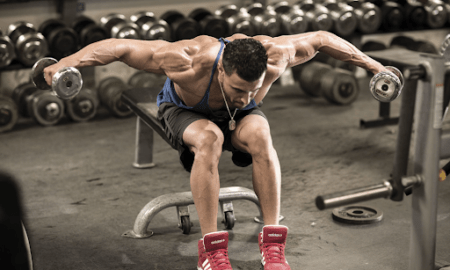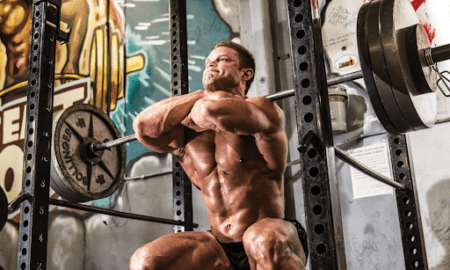Q: I just want the best workout program for building the most muscle. Please simplify all the rhetoric and tell me which one is the absolute best.
A: That’s easy. There is no best routine. It’s the nature of how the human body adapts. That’s why I always say that it takes change to trigger bigger gains. Some experts suggest that the body is fully adapted after only four workouts, and that’s why my program constantly evolves—I’ll rotate in a new exercise, a new X-hybrid tactic, a drop set, etc. After 10 weeks or so I often move to a new program.
If you’re looking for a program you can use for a long stretch that builds both size and strength, try one based on Eric Broser’s Power/Rep Range/Shock protocol. That gives you built-in rep-range changes every week, as follows:
Week 1: Power. You train every exercise with straight sets—no supersets, tri-sets or drop sets—and keep reps in the four-to-six power zone. You use slightly higher reps on endurance-oriented muscles like calves, abs and forearms.
Week 2: Rep Range. For the first exercise you pick a weight that gets you seven to nine reps. For the second exercise you do 10 to 12 reps. On the third exercise you move the range up to the high end of fast-twitch recruitment—13 to 15 reps.
Week 3: Shock. This week is for putting your muscles through the meat grinder with supersets, drop sets and so on. Reps for most muscles stay in the eight-to-10 range, but extended-set techniques are a must.
You can take your current routine and simply change it each week to conform to the Power, Rep Range or Shock protocol. Increase or decrease the weights you use on each exercise to attain the rep-range goals each week. Then on Shock week, combine exercises, do drop sets and blast your muscles into Jell-O. Your first three-week stint will be somewhat erratic because you have to figure out weights for each different protocol; just be sure to write them down.
Incidentally, end-of-set X-Rep partials work well in any of the three protocols, but they’re especially appropriate for Shock workouts. For the uninitiated, at full-range exhaustion you move the bar to the semistretch position, such as near the bottom of an incline press, and grind out 10-inch partials, moving the bar up to just below the halfway point. The controlled-explosion partials extend the set and bring in more fast-twitch growth fibers, as well as increase growth hormone release.
Does P/RR/S work? The first time Jonathan, my training partner, and I tried it, we were shocked. We got strong very quickly. Our work weights kept going up by leaps and bounds at every workout. It was almost frightening but very motivating—plus, our muscle size increased noticeably as well.
After we fully adapted to P/RR/S, about nine weeks, we gave it a rest for a few months and then brought it back, applying it to our original X-Rep transformation program (we christened it X-Rep Reload). We got another round of strength and mass increases.
Remember, you must continually give the muscles something new to cope with to keep them growing. Power/Rep Range/Shock is an excellent way to get automatic variation for size and strength acceleration. [Note: The first P/RR/S program we used is on pages 103-114 of the e-book 3D Muscle Building. The second P/RR/S workout, X-Rep Reload, is on pages 76-84 of the e-book X-traordinary Muscle-Building Workouts. They are available at X-Rep.com.]
Q: I get sore after almost every workout, and I’m still sore the next time I go to the gym. Is it bad to train a muscle when it’s still sore?
A: Scientists believe that muscle soreness is caused by microtears in the fibers. In other words, it’s damage. Training a muscle hard while it’s still sore is like scratching the scab off of a wound. It impairs the healing process and can cause damage that retards proper recovery.
Note that I said training a muscle “hard.” Studies have shown that performing moderate pump-style workouts when a muscle is sore—training that doesn’t do more damage but instead pushes nutrient-rich blood into the muscle—is beneficial to healing and recovery. It also helps replenish glycogen stores to encourage size increases.
I frequently sing the praises of heavy/light training—a heavy, intense workout for a muscle followed a few days later by a lighter, subfailure pumping session. If you’re prone to chronic soreness, I highly recommend using a heavy/light training protocol. You get muscle-fiber trauma at one workout, and three days later you speed the healing and growth process with higher-rep subfailure sets that engorge the recovering muscle. Seeing and feeling a big pump is very motivational as well.
Q: What physiques motivate you, and how do you keep training and pushing so hard in the gym?
A: For me it’s still about building as much muscle as quickly as possible; however, proportion and symmetry are at the forefront—it’s not just about muscle size. In other words, when I peel off my shirt at the beach or lake, I like women to raise an eyebrow, not blow chow. But that’s just me. If you’re into packing as much muscle on your frame as nature will allow, go for it—push your size to the limit. Get your freak physique on.
To maintain the drive to train, you have to strive for the type of physique that appeals to you. To be honest, what really gets me amped is the e-mail I get saying how my training methods, from POF to X Reps, have helped someone get closer to the physique he or she is after. That motivates me to keep experimenting and hitting the gym with a vengeance, and I continue to move closer to my ideals.
What is my ideal? Because of my lighter bone structure, I’m most inspired by early photos of Frank Zane, three-time Mr. Olympia. I may not ever get to his level of development, but I will do my damndest to get close—without drugs, of course.
Q: I’ve been reading about 3D Positions of Flexion, and it makes total sense. Most of the three-way hits for each muscle are straightforward, but I’m confused about midback. Can a row be classified as the big, midrange exercise? With barbell rows the arms squeeze the shoulder blades at the top, which is the contracted position, so are barbell rows both a midrange and contracted exercise?
A: You need to look at the lats and midback together to understand the positions of flexion for each. For lats you use pulldowns or chins as the big, midrange exercise. Then you follow with pullovers for stretch and stiff-arm pulldowns for contracted.
For the midback there’s no need for a midrange exercise—unless you’re specializing. You get midrange midback work on pulldowns or chins when you work lats. Those exercises pull the arms down and back, which affects the lats as well as the midback.
To stretch the midback, the best exercise is one-arm dumbbell rows, moving the dumbbell over and past the centerline of the torso at the bottom of the stroke. That’s the complete stretch position for the midback muscles. Also, as you row the dumbbell to the top, you want to keep your arm angled slightly away from your torso to keep the midback muscles engaged. If you pull with the arm close to your torso so it brushes your side at the top, you activate the lats more than the midback.
So you train your midback’s midrange position with lat work and the stretch position with one-arm dumbbell rows. Next is the contracted position. Bent-arm bent-over laterals work nicely because the move is a combination row and lateral raise, with your arms bent at slightly greater than 90 degrees. You could use bent-over rows instead because, as you observed, the arms retract the scapulae at the top for a complete contraction, but the bent-arm bent-over lateral raise is more isolated. Let’s summarize.
3D POF lat routine: pulldowns (midrange), pullovers (stretch), stiff-arm pulldowns (contracted)
3D POF midback routine: midrange position trained with lat work, one-arm dumbbell rows (stretch) and bent-arm bent-over laterals or bent-over rows (contracted); upper traps—dumbbell shrugs (stretch and contracted)
Notice that the upper traps are a separate animal. To fully develop your upper traps, you should do dumbbell shrugs, which train the stretch and contracted positions. Most trainees get plenty of upper-trap midrange work during their delt routine and from other back exercises, so shrugs should be sufficient.
I always like to remind trainees that POF is a logical way to train without wasting time or effort. You get max force with midrange work, stretch overload with stretch-position exercises and occlusion and continuous tension with contracted-position movements. You also work the full range of motion of each muscle, which improves flexibility and activates more complete development with fewer sets. In other words, you stimulate maximum muscle growth from a number of different pathways. [Note: The new POF manual is the e-book 3D Muscle Building.]
Editor’s note: Steve Holman is the author of many bodybuilding best-sellers and the creator of Positions-of-Flexion muscle training. For information on POF videos and Size Surge programs, see the ad sections beginning on pages 370 and 360, respectively. Also visit www.X-Rep.com for information on X-Rep and 3D POF methods and e-books. IM




















You must be logged in to post a comment Login